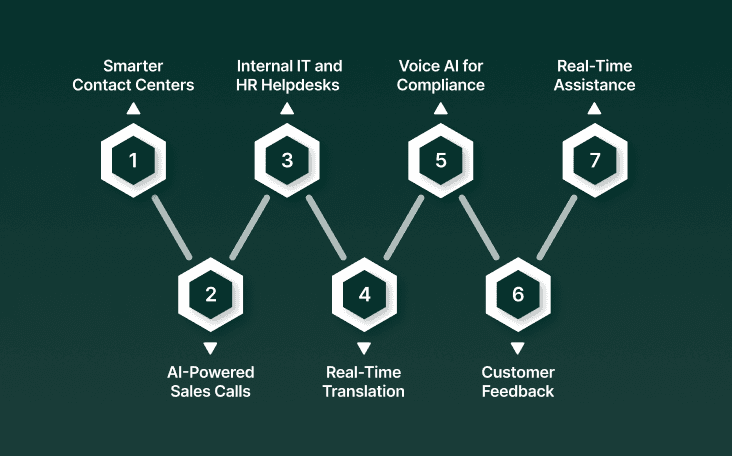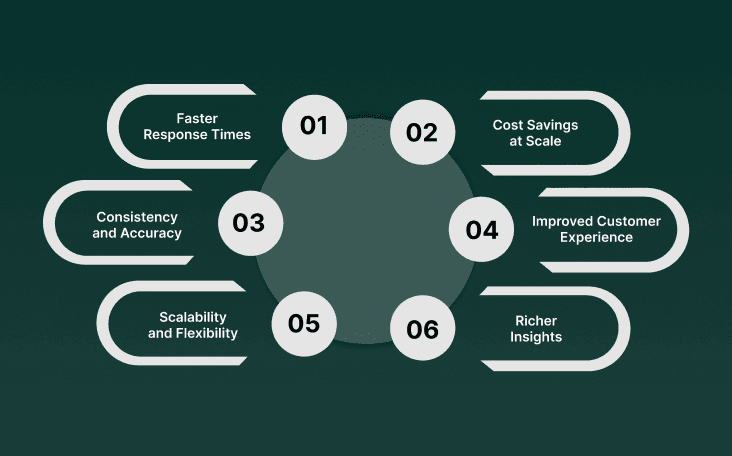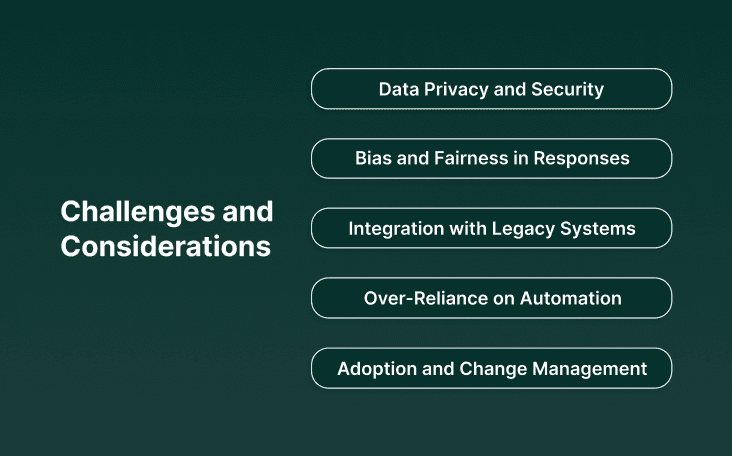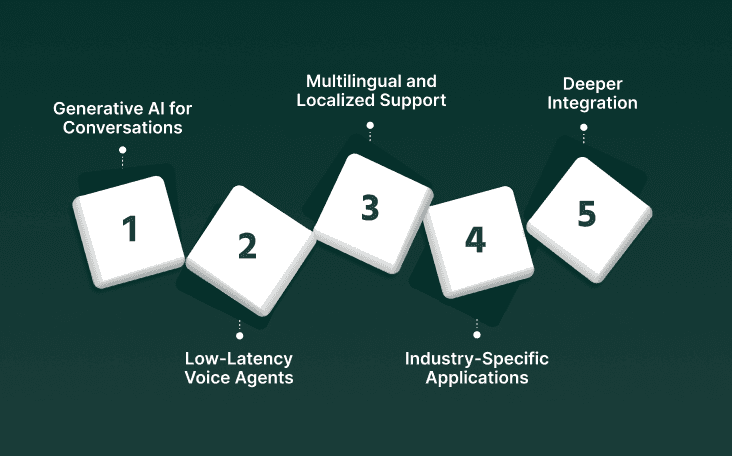The Role of Voice AI in Enterprise Communication Strategy
Explore how voice AI in enterprise communication boosts productivity, customer service, and automation. Discover real use cases and future trends.

Prithvi Bharadwaj
Updated on
December 26, 2025 at 11:28 AM
Enterprise communication has always been central to business success—whether it’s how teams collaborate internally or how companies engage with customers. But traditional systems like static IVRs, email queues, and scripted responses often create friction instead of connection.
That’s why voice AI in enterprise communication is emerging as a transformative force. By combining speech recognition, natural language processing, and real-time synthesis, it enables more natural conversations, faster resolutions, and scalable support across industries.
In this blog, we’ll explore how enterprises are applying voice AI today, the benefits it brings to customer service and internal collaboration, and where the technology is heading next.
Key Takeaways
Voice AI in enterprise communication is no longer experimental—it’s driving measurable ROI in contact centers, sales, IT helpdesks, and collaboration.
The biggest benefits are speed, cost savings, and personalization, with real-time AI voice agents delivering human-like conversations at scale.
Challenges remain around privacy, bias, and legacy integration, but solutions like on-prem deployment and compliance-ready infrastructure address them.
The future is multilingual and real-time, as enterprises adopt generative AI, predictive analytics, and embedded voice assistants in collaboration tools.
Why Voice AI Matters for Enterprise Communication
Enterprises thrive on communication—whether it’s between employees, across global teams, or with customers in moments that define loyalty. Yet many communication systems haven’t kept pace with expectations. Customers still face clunky IVR menus and long hold times, while employees often spend hours navigating outdated internal support systems.
Voice AI changes that dynamic. Instead of rigid scripts, it enables fluid, real-time conversations that sound natural and adapt to context. In practice, this means:
Faster customer interactions: Policy updates, claims intake, or appointment bookings handled in seconds.
Smarter internal collaboration: IT helpdesk, HR queries, and knowledge retrieval made conversational and instant.
Scalable communication: Enterprises can serve thousands of simultaneous interactions without sacrificing quality.
According to IBM’s insights on the rise of voice AI, businesses adopting conversational AI see improvements not only in efficiency but also in customer satisfaction—because natural voice interactions feel more human and less transactional.
For enterprises, voice AI is no longer about if but how fast they can implement it across the communication stack.
7 Practical Use Cases of Voice AI in Enterprise Communication

1. Smarter Contact Centers
Voice AI transforms contact centers by handling routine inquiries—like billing questions, order updates, or password resets—without long hold times. Unlike legacy IVR systems, AI-driven agents can understand interruptions, process intent, and respond naturally, freeing human agents to focus on complex cases.
Learn how real-time performance makes this possible: Why Streaming Architecture Is Non-Negotiable for Real-Time Voice Agents.
2. AI-Powered Sales Calls
Enterprise sales teams use voice AI to pre-qualify leads, schedule demos, and even conduct outbound campaigns. Instead of scripted robocalls, these agents adapt to live conversations, ensuring prospects feel heard while capturing structured data directly into CRMs.
3. Internal IT and HR Helpdesks
Employees often wait hours (or days) for IT tickets or HR requests. Voice AI creates conversational helpdesks where staff can reset passwords, check leave balances, or get policy updates instantly—improving productivity and reducing internal bottlenecks.
4. Real-Time Language Translation
Global enterprises often struggle with multilingual support. Voice AI bridges that gap by offering real-time translation and localized voices, helping teams collaborate across regions and customers receive support in their preferred language.
5. Voice AI for Compliance and Audit Logging
Highly regulated industries—like healthcare, finance, and insurance—benefit from AI systems that can record, transcribe, and analyze calls for compliance. Automated logs reduce the risk of human error and make audits faster and more accurate.
6. Customer Feedback and Surveys
Instead of pushing web forms or long emails, enterprises are deploying voice AI to gather feedback conversationally. This not only improves response rates but also provides richer insights because people tend to share more detail when speaking naturally.
7. Real-Time Meeting Assistance
In hybrid workplaces, voice AI acts as a meeting assistant—transcribing conversations, generating action points, and even summarizing discussions across languages. This helps distributed teams collaborate more effectively without missing critical details.
Related read: What We Learned From Benchmarking Real-Time AI Agents.
Benefits of Voice AI in Enterprise Communication

Enterprises don’t adopt new technology for novelty—they adopt it for measurable outcomes. The benefits of deploying voice AI in enterprise communication go beyond efficiency, creating long-term value across operations and customer experience.
1. Faster Response Times
Voice AI ensures that customers and employees get answers instantly, without waiting on hold or navigating endless menus. This reduces frustration and increases satisfaction.
2. Cost Savings at Scale
By automating routine calls and requests, enterprises lower their reliance on large support teams. Enterprises that deploy AI in contact centers can reduce operational costs significantly while maintaining high service quality.
3. Consistency and Accuracy
Unlike human agents who may vary in tone or accuracy, voice AI provides consistent responses—important in industries where compliance and precision matter. Transcripts and logs further enhance auditability.
4. Improved Customer Experience
Natural, real-time conversations make interactions feel human rather than scripted. Customers appreciate being understood, supported in their own language, and offered personalized solutions.
5. Scalability and Flexibility
AI systems can handle thousands of concurrent conversations without added overhead. Whether it’s peak holiday call volumes or sudden surges during product launches, enterprises can scale without service degradation.
6. Richer Insights
Every interaction can be transcribed, analyzed, and mined for insights—helping enterprises identify customer pain points, track sentiment, and improve products or services over time.
For a deeper dive into how latency and naturalness shape these benefits, see Real-Time TTS Conversion Using AI.
Challenges and Considerations of Voice AI in Enterprise Communication

While the advantages are clear, enterprises need to carefully manage the risks and complexities of implementing voice AI in enterprise communication.
1. Data Privacy and Security
Voice interactions often involve sensitive information—whether it’s customer account numbers, medical details, or employee HR queries. Enterprises must ensure that AI systems encrypt data, comply with regulations like GDPR and HIPAA, and prevent unauthorized access.
2. Bias and Fairness in Responses
AI models trained on biased data can lead to inconsistent or unfair treatment of users, especially in diverse global organizations. Enterprises need to regularly test, audit, and retrain models to minimize bias.
3. Integration with Legacy Systems
Voice AI delivers the most value when connected to CRMs, ERPs, and telephony platforms. But integration with legacy infrastructure can be complex, requiring APIs, middleware, and change management. Enterprises should plan for phased rollouts rather than “big bang” deployments.
4. Over-Reliance on Automation
While AI can handle routine queries exceptionally well, some situations—like escalations or sensitive HR issues—still require a human touch. Enterprises need clear escalation paths to balance automation with empathy.
5. Adoption and Change Management
Employees may initially resist AI, fearing job displacement. Success depends on positioning voice AI as a tool that augments rather than replaces staff—freeing them to focus on higher-value work. Training and communication are critical for adoption.
Future of Voice AI in Enterprise Communication

Voice AI is moving from experimental deployments to becoming a core layer of enterprise infrastructure. Over the next few years, several trends will define its evolution:
1. Generative AI for Smarter Conversations
Large language models will enable enterprise voice systems to handle open-ended queries, generate personalized responses, and adapt tone based on context. Instead of scripted flows, conversations will feel increasingly dynamic and natural.
2. Real-Time, Low-Latency Voice Agents
Latency is the difference between a fluid conversation and a frustrating pause. Enterprises will prioritize real-time voice AI infrastructure capable of sub-200ms responses. This ensures that interactions with customers or employees feel as smooth as speaking with a human colleague.
Dive deeper here: What Makes a Real-Time Agent Truly Real-Time.
3. Multilingual and Localized Support
As enterprises expand globally, voice AI will provide instant multilingual support, adapting to local dialects and cultural nuances. This not only improves customer experience but also reduces the need for large, region-specific support teams.
4. Industry-Specific Applications
Voice AI will increasingly be tailored to industry contexts:
Healthcare: Appointment scheduling and patient intake.
Insurance: Claims reporting and policy updates.
E-commerce: Order status and returns management.
Finance: Fraud alerts and transaction confirmations.
5. Deeper Integration with Collaboration Tools
In hybrid workplaces, voice AI assistants will become embedded in platforms like Microsoft Teams, Zoom, and Slack—handling meeting transcriptions, generating summaries, and ensuring follow-up tasks aren’t missed.
As IBM notes, enterprises that adopt these capabilities early won’t just improve communication efficiency—they’ll redefine the standard for how organizations interact with customers and employees alike.
How Smallest.ai Enables Enterprise Voice AI
For enterprises, the challenge isn’t just experimenting with AI—it’s deploying it at scale, in real time, and with compliance built in. That’s exactly where Smallest.ai stands out.
1. Real-Time Voice Agents for Enterprise Workflows
Customer-facing support: Handle thousands of simultaneous calls with sub-100ms latency, so conversations feel natural and human.
Internal helpdesks: Automate IT and HR requests, freeing employees from waiting in long queues.
Sales enablement: Pre-qualify leads, capture structured data, and schedule meetings directly into CRMs.
2. Multilingual and Personalized Experiences
With Lightning-v2 multilingual TTS, enterprises can engage customers across regions in their local language, accent, and tone. This isn’t just translation—it’s communication that feels authentic.
3. Enterprise-Grade Security and Compliance
From finance to healthcare, enterprises can’t compromise on compliance. Smallest supports on-premises and VPC deployments, aligned with SOC 2, HIPAA, and PCI requirements. Sensitive conversations stay protected, without sacrificing speed.
4. Seamless Integration with Existing Systems
Smallest’s APIs and SDKs connect easily with CRMs, telephony systems, and collaboration platforms. This makes it possible to adopt AI voice capabilities without costly infrastructure overhauls.
Tangible Impact for Enterprises
By deploying Smallest’s voice AI, organizations achieve:
Reduced operational costs by automating high-volume interactions.
Higher customer satisfaction thanks to instant, natural responses.
Better employee productivity through AI-powered internal helpdesks.
Ready to see what voice AI in enterprise communication can do for your organization? Explore Smallest.ai’s Enterprise Solutions today.
FAQs on Voice AI in Enterprise Communication
1. What is voice AI in enterprise communication?
Voice AI uses speech recognition, natural language processing, and real-time synthesis to enable natural conversations between enterprises, employees, and customers.
2. How are enterprises using voice AI today?
Key applications include customer support, sales calls, IT and HR helpdesks, multilingual service, compliance logging, and real-time meeting assistance.
3. What are the benefits of voice AI in enterprise communication?
Benefits include faster response times, cost savings, consistent accuracy, personalized experiences, and scalability across thousands of interactions.
4. What challenges do enterprises face when adopting voice AI?
The main challenges are data privacy, algorithmic bias, integration with legacy systems, over-reliance on automation, and employee adoption hurdles.
5. How does voice AI improve customer experience?
By responding instantly, supporting multiple languages, and handling interruptions naturally, voice AI makes customer interactions feel more human and efficient.
6. What’s the future of voice AI in enterprise communication?
Expect growth in generative AI-driven conversations, real-time multilingual support, and deep integration into collaboration tools like Teams and Zoom.
Enterprise communication has always been central to business success—whether it’s how teams collaborate internally or how companies engage with customers. But traditional systems like static IVRs, email queues, and scripted responses often create friction instead of connection.
That’s why voice AI in enterprise communication is emerging as a transformative force. By combining speech recognition, natural language processing, and real-time synthesis, it enables more natural conversations, faster resolutions, and scalable support across industries.
In this blog, we’ll explore how enterprises are applying voice AI today, the benefits it brings to customer service and internal collaboration, and where the technology is heading next.
Key Takeaways
Voice AI in enterprise communication is no longer experimental—it’s driving measurable ROI in contact centers, sales, IT helpdesks, and collaboration.
The biggest benefits are speed, cost savings, and personalization, with real-time AI voice agents delivering human-like conversations at scale.
Challenges remain around privacy, bias, and legacy integration, but solutions like on-prem deployment and compliance-ready infrastructure address them.
The future is multilingual and real-time, as enterprises adopt generative AI, predictive analytics, and embedded voice assistants in collaboration tools.
Why Voice AI Matters for Enterprise Communication
Enterprises thrive on communication—whether it’s between employees, across global teams, or with customers in moments that define loyalty. Yet many communication systems haven’t kept pace with expectations. Customers still face clunky IVR menus and long hold times, while employees often spend hours navigating outdated internal support systems.
Voice AI changes that dynamic. Instead of rigid scripts, it enables fluid, real-time conversations that sound natural and adapt to context. In practice, this means:
Faster customer interactions: Policy updates, claims intake, or appointment bookings handled in seconds.
Smarter internal collaboration: IT helpdesk, HR queries, and knowledge retrieval made conversational and instant.
Scalable communication: Enterprises can serve thousands of simultaneous interactions without sacrificing quality.
According to IBM’s insights on the rise of voice AI, businesses adopting conversational AI see improvements not only in efficiency but also in customer satisfaction—because natural voice interactions feel more human and less transactional.
For enterprises, voice AI is no longer about if but how fast they can implement it across the communication stack.
7 Practical Use Cases of Voice AI in Enterprise Communication

1. Smarter Contact Centers
Voice AI transforms contact centers by handling routine inquiries—like billing questions, order updates, or password resets—without long hold times. Unlike legacy IVR systems, AI-driven agents can understand interruptions, process intent, and respond naturally, freeing human agents to focus on complex cases.
Learn how real-time performance makes this possible: Why Streaming Architecture Is Non-Negotiable for Real-Time Voice Agents.
2. AI-Powered Sales Calls
Enterprise sales teams use voice AI to pre-qualify leads, schedule demos, and even conduct outbound campaigns. Instead of scripted robocalls, these agents adapt to live conversations, ensuring prospects feel heard while capturing structured data directly into CRMs.
3. Internal IT and HR Helpdesks
Employees often wait hours (or days) for IT tickets or HR requests. Voice AI creates conversational helpdesks where staff can reset passwords, check leave balances, or get policy updates instantly—improving productivity and reducing internal bottlenecks.
4. Real-Time Language Translation
Global enterprises often struggle with multilingual support. Voice AI bridges that gap by offering real-time translation and localized voices, helping teams collaborate across regions and customers receive support in their preferred language.
5. Voice AI for Compliance and Audit Logging
Highly regulated industries—like healthcare, finance, and insurance—benefit from AI systems that can record, transcribe, and analyze calls for compliance. Automated logs reduce the risk of human error and make audits faster and more accurate.
6. Customer Feedback and Surveys
Instead of pushing web forms or long emails, enterprises are deploying voice AI to gather feedback conversationally. This not only improves response rates but also provides richer insights because people tend to share more detail when speaking naturally.
7. Real-Time Meeting Assistance
In hybrid workplaces, voice AI acts as a meeting assistant—transcribing conversations, generating action points, and even summarizing discussions across languages. This helps distributed teams collaborate more effectively without missing critical details.
Related read: What We Learned From Benchmarking Real-Time AI Agents.
Benefits of Voice AI in Enterprise Communication

Enterprises don’t adopt new technology for novelty—they adopt it for measurable outcomes. The benefits of deploying voice AI in enterprise communication go beyond efficiency, creating long-term value across operations and customer experience.
1. Faster Response Times
Voice AI ensures that customers and employees get answers instantly, without waiting on hold or navigating endless menus. This reduces frustration and increases satisfaction.
2. Cost Savings at Scale
By automating routine calls and requests, enterprises lower their reliance on large support teams. Enterprises that deploy AI in contact centers can reduce operational costs significantly while maintaining high service quality.
3. Consistency and Accuracy
Unlike human agents who may vary in tone or accuracy, voice AI provides consistent responses—important in industries where compliance and precision matter. Transcripts and logs further enhance auditability.
4. Improved Customer Experience
Natural, real-time conversations make interactions feel human rather than scripted. Customers appreciate being understood, supported in their own language, and offered personalized solutions.
5. Scalability and Flexibility
AI systems can handle thousands of concurrent conversations without added overhead. Whether it’s peak holiday call volumes or sudden surges during product launches, enterprises can scale without service degradation.
6. Richer Insights
Every interaction can be transcribed, analyzed, and mined for insights—helping enterprises identify customer pain points, track sentiment, and improve products or services over time.
For a deeper dive into how latency and naturalness shape these benefits, see Real-Time TTS Conversion Using AI.
Challenges and Considerations of Voice AI in Enterprise Communication

While the advantages are clear, enterprises need to carefully manage the risks and complexities of implementing voice AI in enterprise communication.
1. Data Privacy and Security
Voice interactions often involve sensitive information—whether it’s customer account numbers, medical details, or employee HR queries. Enterprises must ensure that AI systems encrypt data, comply with regulations like GDPR and HIPAA, and prevent unauthorized access.
2. Bias and Fairness in Responses
AI models trained on biased data can lead to inconsistent or unfair treatment of users, especially in diverse global organizations. Enterprises need to regularly test, audit, and retrain models to minimize bias.
3. Integration with Legacy Systems
Voice AI delivers the most value when connected to CRMs, ERPs, and telephony platforms. But integration with legacy infrastructure can be complex, requiring APIs, middleware, and change management. Enterprises should plan for phased rollouts rather than “big bang” deployments.
4. Over-Reliance on Automation
While AI can handle routine queries exceptionally well, some situations—like escalations or sensitive HR issues—still require a human touch. Enterprises need clear escalation paths to balance automation with empathy.
5. Adoption and Change Management
Employees may initially resist AI, fearing job displacement. Success depends on positioning voice AI as a tool that augments rather than replaces staff—freeing them to focus on higher-value work. Training and communication are critical for adoption.
Future of Voice AI in Enterprise Communication

Voice AI is moving from experimental deployments to becoming a core layer of enterprise infrastructure. Over the next few years, several trends will define its evolution:
1. Generative AI for Smarter Conversations
Large language models will enable enterprise voice systems to handle open-ended queries, generate personalized responses, and adapt tone based on context. Instead of scripted flows, conversations will feel increasingly dynamic and natural.
2. Real-Time, Low-Latency Voice Agents
Latency is the difference between a fluid conversation and a frustrating pause. Enterprises will prioritize real-time voice AI infrastructure capable of sub-200ms responses. This ensures that interactions with customers or employees feel as smooth as speaking with a human colleague.
Dive deeper here: What Makes a Real-Time Agent Truly Real-Time.
3. Multilingual and Localized Support
As enterprises expand globally, voice AI will provide instant multilingual support, adapting to local dialects and cultural nuances. This not only improves customer experience but also reduces the need for large, region-specific support teams.
4. Industry-Specific Applications
Voice AI will increasingly be tailored to industry contexts:
Healthcare: Appointment scheduling and patient intake.
Insurance: Claims reporting and policy updates.
E-commerce: Order status and returns management.
Finance: Fraud alerts and transaction confirmations.
5. Deeper Integration with Collaboration Tools
In hybrid workplaces, voice AI assistants will become embedded in platforms like Microsoft Teams, Zoom, and Slack—handling meeting transcriptions, generating summaries, and ensuring follow-up tasks aren’t missed.
As IBM notes, enterprises that adopt these capabilities early won’t just improve communication efficiency—they’ll redefine the standard for how organizations interact with customers and employees alike.
How Smallest.ai Enables Enterprise Voice AI
For enterprises, the challenge isn’t just experimenting with AI—it’s deploying it at scale, in real time, and with compliance built in. That’s exactly where Smallest.ai stands out.
1. Real-Time Voice Agents for Enterprise Workflows
Customer-facing support: Handle thousands of simultaneous calls with sub-100ms latency, so conversations feel natural and human.
Internal helpdesks: Automate IT and HR requests, freeing employees from waiting in long queues.
Sales enablement: Pre-qualify leads, capture structured data, and schedule meetings directly into CRMs.
2. Multilingual and Personalized Experiences
With Lightning-v2 multilingual TTS, enterprises can engage customers across regions in their local language, accent, and tone. This isn’t just translation—it’s communication that feels authentic.
3. Enterprise-Grade Security and Compliance
From finance to healthcare, enterprises can’t compromise on compliance. Smallest supports on-premises and VPC deployments, aligned with SOC 2, HIPAA, and PCI requirements. Sensitive conversations stay protected, without sacrificing speed.
4. Seamless Integration with Existing Systems
Smallest’s APIs and SDKs connect easily with CRMs, telephony systems, and collaboration platforms. This makes it possible to adopt AI voice capabilities without costly infrastructure overhauls.
Tangible Impact for Enterprises
By deploying Smallest’s voice AI, organizations achieve:
Reduced operational costs by automating high-volume interactions.
Higher customer satisfaction thanks to instant, natural responses.
Better employee productivity through AI-powered internal helpdesks.
Ready to see what voice AI in enterprise communication can do for your organization? Explore Smallest.ai’s Enterprise Solutions today.
FAQs on Voice AI in Enterprise Communication
1. What is voice AI in enterprise communication?
Voice AI uses speech recognition, natural language processing, and real-time synthesis to enable natural conversations between enterprises, employees, and customers.
2. How are enterprises using voice AI today?
Key applications include customer support, sales calls, IT and HR helpdesks, multilingual service, compliance logging, and real-time meeting assistance.
3. What are the benefits of voice AI in enterprise communication?
Benefits include faster response times, cost savings, consistent accuracy, personalized experiences, and scalability across thousands of interactions.
4. What challenges do enterprises face when adopting voice AI?
The main challenges are data privacy, algorithmic bias, integration with legacy systems, over-reliance on automation, and employee adoption hurdles.
5. How does voice AI improve customer experience?
By responding instantly, supporting multiple languages, and handling interruptions naturally, voice AI makes customer interactions feel more human and efficient.
6. What’s the future of voice AI in enterprise communication?
Expect growth in generative AI-driven conversations, real-time multilingual support, and deep integration into collaboration tools like Teams and Zoom.
Related Blogs
Lead with Precision, Speak with Purpose: What Smallest.ai Shares with Emmanuel Macron
Nov 25, 2025
Conversational AI in Customer Service: 4 Use Cases And Steps
Dec 18, 2025
The Future of AI in Customer Service: What Comes Next
Dec 18, 2025
9 Ways Contact Center AI Is Changing Customer Calls Forever
Dec 18, 2025
How Generative AI in Financial Services is Defining 2025 ROI
Dec 18, 2025


